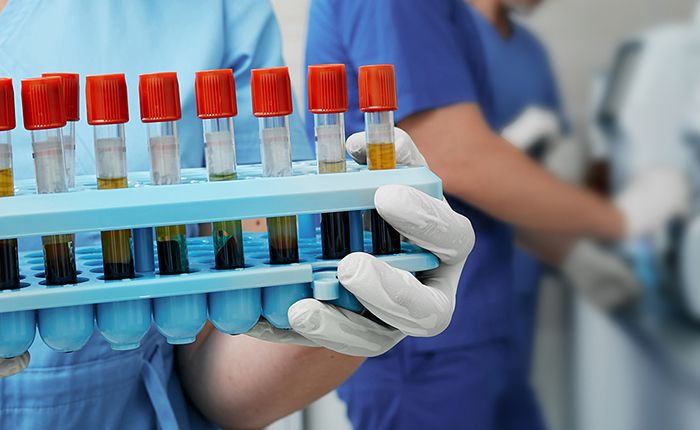January 24, 2024
As we turn our sights to 2024, let’s look at what’s in store for labs this year. Spoiler: staffing shortages, AI, costs, outreach and data security make the list.
Staffing shortages will continue to plague healthcare
In July 2023, a coalition of laboratory organizations submitted a letter to the U.S. Congress requesting action to address the growing shortage of laboratory personnel. The shortage is due to a number of factors including high educational costs; lack of familiarity with laboratory medicine as a career option; declines in the number of training programs and students trained; high workload, stress, and burnout.
According to the letter, “Currently, most medical and public health laboratories suffer from significant personnel shortages, and many are operating at or near crisis mode. Staffing shortages now have the potential to undermine the ability of these laboratories to provide timely test results, which is imperative to both the public health and patient access to quality care.”
While the coalition urged Congress to include lab professionals in federal workforce programs they are currently ineligible to participate in, more and faster action will be needed to resolve the shortage by the end of 2024.
Other recommendations to resolve staffing shortages can be found in this May 2023 Medical Laboratory Observer article, including
- Investing in longer-term solutions to acquire, develop, and retain talent.
- Training existing staff working in non-technical roles with a desire for more options.
- Reducing turnover through professional development programs.
- Innovation.
One innovative way to reduce turnover due to burnout and reduce costs associated with short-term staffing solutions is to ensure lab staff scheduling is as efficient as possible. This can be done by predicting likely specimen volume in each department and then adjusting staffing levels accordingly. hc1 President Michael Braverman recently shared in MedCity News that “once time is lost, you can never get it back. Real-time insights enable laboratories to be more proactive, strategic, and responsive in managing their staffing needs and mitigating the impact of market forces affecting labor shortages. By using data to guide decision-making, labs can foster a stable and productive workforce, even in the face of dynamic market conditions.”
hc1 Workforce Optimization, which will become available to all laboratories in early 2024, uses Artificial Intelligence (AI) and Machine Learning (ML) trained on combined testing and timekeeping data to recommend the most likely scheduling adjustments to create maximum efficiency. American Oncology Network (AON), a rapidly growing network of community-based oncology practices nationwide, will be the first to use the solution.
“Lab results have downstream implications for our providers and patients,” said Curtiss McNair, VP of laboratory services for AON, in a press release announcing hc1 and AON’s development partnership in June 2023. “This partnership enables us to develop better processes with real-time actionable insights into our data and imparts us with forward-thinking recommendations based on a detailed analysis to optimize staffing and expenses,” McNair added.
Laboratories will find more innovative ways to use AI
Through solutions like hc1 Workforce Optimization, AI will be used to create efficiencies and help offset staffing shortages. Other uses for AI in the lab include recognition of patterns in images, such as whole slide pathology imaging, cell-based imaging and breast cancer screening.
For laboratories to expand their use of AI, they will need to address data storage and complexity issues first. To facilitate the move toward AI/ML, Medical Laboratory Observer says that “if we consider a wider scope and complexity of data sources, this raises significant challenges from the technical issue of aggregating vast datasets obtained from diverse sources to the crucial human aspect of securing consent for personal data usage and safeguarding privacy.”
Overcoming these challenges is entirely possible and worth the effort, as Melody Boudreaux Nelson, DCLS, MS, MLS(ASCP)CM wrote in Medical Lab Management in March 2023, “For the medical laboratory, AI adoption offers a unique opportunity—a traceable “70%” (or greater) contribution to medical decisions. “
According to hc1 VP, Data Strategy, Chuck Girard, “Encouraging innovation within laboratories drives advancements in diagnostic techniques, technologies, and treatment methods.“
He said, “Labs must consider what they’ll need to do to be good partners to the health systems and providers that they serve as they pursue innovation. One way of doing that is to find technology partners that can help them manage and curate the lab’s data to better support clients’ needs. A good partner will not only offer best-in-class technology, but will pair it with deep subject matter expertise in the lab space. The partner will know what makes lab data challenging to work with and will offer technology solutions that overcome those challenges to optimize the lab data for innovative AI/ML-driven use cases.”
Healthcare leaders will invest more in cybersecurity
With the increasing volume of data being generated by healthcare, data security will be a continuing concern in 2024. Becker’s Health IT reporting on a recent Guidehouse analysis noted the top IT investment for 2024 is projected to be cybersecurity at 55%.
The planned investment increase in cybersecurity spending signals that healthcare systems are taking the need for more protection against threats like ransomware attacks and data breaches seriously. In August 2023, Medical Economics reported that 327 data breaches had been reported to the U.S. Department of Health and Human Services’ Office for Civil Rights so far, a more than 104% increase over the prior year. Data of more than 40 million individual patients was involved in cyberattacks by August 2023, a 60% increase year-over-year.
According to Chris Toth, director of compliance and risk management at hc1 Insights, “The security of all data is not something to be taken lightly and regardless if it is customer or patient data, it should be encrypted from cradle to grave as it takes the guesswork out of it. As cybersecurity threats continue to emerge, health IT leaders need to demonstrate that their organization takes not only data security and privacy but risk management seriously.”
hc1’s own investment in achieving HITRUST Risk-based, 2-year Certification demonstrates to our customers our commitment to the highest standards for data protection and information security. Watch this video to learn more about how and why hc1 chose to pursue HITRUST Certification.
Rising costs will continue to be a concern
Staffing shortages and inflation have certainly led to increases in labor and supply costs for laboratories and are unfortunately expected to continue.
Labor accounts for nearly half of health systems’ budgets and, according to the American Hospital Association, has increased more than 20 percent since 2019 and clinical labor costs are projected to grow 6 to 10 percent in 2023-24, about three to seven percentage points above the prevailing rate of inflation.
Meanwhile, lab equipment and IT software prices are projected to increase an average of 4.2% in 2023, while reagent, energy and labor costs are also expected to increase.10
In addition, labs are finding that more complex testing leads to the need for new instruments and continuing education for technicians. Molecular and other advanced testing types firmly established a foothold in laboratories in response to the COVID-19 pandemic. Now that the value of PCR testing for infectious diseases has been widely recognized, laboratories are increasingly expected to expand the scope of their existing testing capabilities to include more analytes and observations. Demand for genetic testing has also increased. By November 2022, U.S. physicians could choose from 129,624 genetic tests to order. These new tests can be highly complex and require new techniques, expensive reagents and equipment, as well as advanced skill sets.
Optimizing use of resources will be one key way labs will be able to lower costs in 2024. Automation and AI will also have a role to play in lowering costs, as well as improving efficiency in billing so as to avoid unnecessary write-offs.
Improving laboratory stewardship will be key for value-based health systems. Leveraging usage data and automated decision support is proving to be highly successful in reducing unnecessary test orders and costs. The savings that can be realized through implementing an effective utilization program can more than make up for the expense of putting the appropriate resources and team in place to do so. Estimates project that healthcare systems could reduce costs up to $5 billion per year if they were just to eliminate redundant tests.
One large, midwestern health system utilized hc1 PrecisionDx Advisor to launch a test utilization program across 12 hospitals, driving measurable, positive change. With real-time visibility and a clear focus for initial improvement, this health system was able to quickly compare utilization trends by site location, physician and several other attributes in order to bring issues and opportunities to light. Substantial reductions in the utilization rates of individual analytes at the hospital level were achieved within 15 months. Ultimately, the system-wide impact of these efforts was a 5.6% reduction in lab tests per patient per day, which amounted to 147,000 fewer unnecessary tests per year and a conservative cost savings of $383,000.
Healthcare systems will increase focus on laboratory outreach
In an effort to offset costs, healthcare system laboratories will also look to expand their outreach programs. According to a report from the American Hospital Association, over half of hospitals ended 2022 operating at a financial loss, primarily due to hospital expense growth outpacing Medicare reimbursement by about 10 percent.
To combat these financial challenges, health systems are looking for ways to “launch new lines of business, add new services and find ways to differentiate,” according to Optum. Their survey of 150 healthcare leaders found that 49 percent consider growth one of the industry’s top challenges. “Hospital-based labs across the United States are forging ahead with their lab outreach services in ways that generate many benefits,” said Jane Hermansen, manager of outreach and network development at Mayo Clinic Laboratories, in an interview with Dark Daily.
Health system lab outreach programs can offer several benefits because of their community-based locations, available capacity and ability to often turn around test results faster than a lab outside the area.
Labs looking to grow their outreach programs will benefit from increasing focus on customer relationship management. Feedback on service quality, turnaround times, and any issues that may arise will help enhance the partnership over time.
A robust operations and customer relationship management (CRM) solution integrated with the Laboratory Information System (LIS) using a real-time HL7 interface can provide the actionable insights and data necessary to target and engage prospects and service existing outreach clients.
hc1 clients leveraging hc1 Operations Management™ and hc1 Performance Analytics™ have grown their outreach labs by as much as 90% in less than five years. Read this past hc1 blog post for five things contributing to their success.
Bonus Prediction: Lab industry growth in 2024 is inevitable
The global clinical laboratory service market size is expected to expand at a compound annual growth rate (CAGR) of 3.2% from 2023 to 2030. Demand for diagnostic testing continues to rise, spurred by an increasing prevalence of chronic diseases and an aging population. Noncommunicable diseases are widespread, particularly in the United States, where nearly 60% of adults live with at least one chronic condition. Globally, the aging population is also growing and will likely need increased care and testing in the coming year. The share of the global population aged 65 and older is projected to rise from 10% in 2022 to 16% in 2050. At that point, the number of persons aged 65 years or over worldwide is expected to be more than twice the number of children under age 5 and about the same as the number under age 12.
As labs look to address the challenges presented by this increase in demand with fewer resources, hc1 is ready to help. We aren’t just delivering technology solutions for laboratories. We’re empowering healthcare to make people healthier. We get to know our clients and what they need and work with them to continuously innovate with lab data. Request a demo to discuss how we can work together to solve your lab’s challenges.
_______________________________________________________________________
Lauren VanDenBoom, vice president of marketing at hc1 Insights leads hc1’s marketing team in their efforts to advance awareness of hc1’s unique capabilities and vision. Lauren’s background includes more than 18 years of lab industry marketing and communications including key marketing roles in toxicology and women’s health-focused laboratories.




